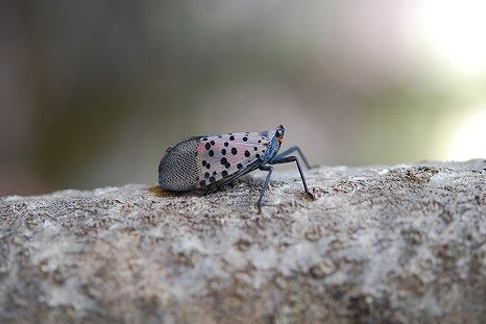- AppliancesElectriciansHVACLandscapingLocksmithPest ControlPlumbingRenovationRoofingT V RepairAll Home Improvement
- Car AccidentClass ActionCorporate LawCriminal DefenseDivorce LawEmployment LawFamily LawFinancial LawLegal AidMedical Injury LawyersMedical MalpracticeReal Estate LawWater Fire RestorationAll Legal
- InvestmentRetirementAll Finance
- Animal InsuranceAutoGeneral InsuranceHealth PolicyHome RentersAll Insurance
- DentalHealth SpecialistsAll Medical
- Animal CareVeterinaryAll Pets
- Auto GlassTowingAll Automotive
What Are Spotted Lanternflies?

If you've ever spotted a beautiful critter with red and white polka dot wings flying around your garden, you may have come face-to-face with the spotted lanternfly. Often mistaken for unique-looking butterflies, spotted lanternflies are actually part of the planthopper species. And they sure do plant-hop.
Read More Pest Control Articles
Lanternflies are considered an invasive species, and they're particularly fond of grape vineyards and sap-producing trees. If left to their own devices, lanternflies can cause significant damage to crops, trees and plant life.
Spotted lanternflies are native to Asia and were first detected in the United States in 2014. Part of the planthopper species, spotted lanternflies are winged insects with distinct spots on their wings and bright red abdomens with black and white markings. The adult lanternfly also has a set of red hind wings with black spots. At first glance, the adult lanternfly is similar in appearance to a butterfly.
As nymphs, lanternflies are either black or red in color with distinct white markings. Lanternfly nymphs jump instead of fly, and they're known to jump extremely high to avoid predators.
Why Are Spotted Lanternflies Bad?
While there's no denying the spotted lanternfly is a beautiful creature, it has a terrible reputation. This is because spotted lanternflies possess the ability to destroy sap-producing trees and vineyards, which can lead to serious financial and physical losses for farmers and growers.
Spotted lanternflies feed in large numbers, and they cause damage by sucking sap from maple and walnut trees and juice from vineyard grapes. As they feed, the lanternflies release waste products that can lead to fungal diseases and destroy entire trees and grapevines.
Spotted lanternflies are an invasive species, which means they travel from their native habitats to nonnative areas. In nonnative areas, there are no natural predators to deter the lanternfly. A lack of a natural enemy allows the lanternflies to multiply at a rapid rate.
If you're concerned about a spotted lanternfly infestation, it's important to consult with a pest control professional before attempting to mitigate the situation on your own. These insects multiply quickly, and they often travel in groups. Your pest control specialist may recommend treating your trees and plants with insecticide to keep the lanternflies at bay, or they may suggest the following home remedies:
- Vinegar: Spraying vinegar directly on lanternflies will usually kill them on contact. However, vinegar may damage the underlying plant or tree, so it's important to use it with caution.
- Soap and water mixture: Mix 1/4 cup liquid dish soap with a tablespoon of vegetable oil and a quart of water. Use a spray bottle to apply the spray directly to the offending lanternflies. The heavy soap and vegetable oil should suffocate the insects on contact.
- Sticky wrap: Wrapping your tree trunks with sticky bands creates a tacky barrier that may help prevent the lanternflies from traveling up the tree and accessing the sap.
More Related Articles:
- What to Look For When Hiring an Exterminator
- Are Pest Control Products Dangerous For Kids and Pets?
- What Are Ultrasonic Pest Repellers?
- 10 Ways to Prevent Termites
- How to Spray for Mosquitoes
What Should You Do If You Spot a Spotted Lanternfly?
If you see a spotted lanternfly, it's important to follow the reporting guidelines of your state. Spotted lanternflies have been found in 17 U.S. states, and their presence continues to grow. State agencies are working hard to control this invasive species, which makes your input essential.
Some states ask that people take photos of the lanternflies, while other states recommend destroying the insects and sending samples to state agricultural departments. Many states have online reporting tools to make the process easier.
You can also send in photos or video of suspected lanternfly activity, even if you don't see a physical bug. Some common signs of spotted lanternfly activity include sooty mold on outdoor plants, oozing or weeping plants with pungent odors and sticky fluid buildup on and beneath infested plants.
Elocal Editorial Content is for educational and entertainment purposes only. Editorial Content should not be used as a substitute for advice from a licensed professional in your state reviewing your issue. Systems, equipment, issues and circumstances vary. Follow the manufacturer's safety precautions. The opinions, beliefs and viewpoints expressed by the eLocal Editorial Team and other third-party content providers do not necessarily reflect the opinions, beliefs and viewpoints of eLocal or its affiliate companies. Use of the Blog is subject to the
Website Terms and Conditions.The eLocal Editorial Team operates independently of eLocal USA's marketing and sales decisions.



